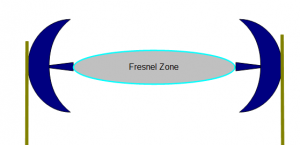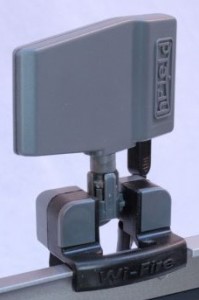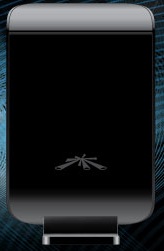When you think of WiFi, you think of something that can provide connectivity up to about 100′ away. In the last post we talked about how a high-power access point can extend that up to half a mile away or more. But WiFi can go for miles, and some WiFi gear can be used to send a high-bandwidth signal tens of miles.
One of the keys in any long-distance UHF signal (radio signals higher than 300 MHz; WiFi is at 2.4 GHz. or 5.8 GHz.) is what is called “line of sight,” and the key concept in line of sight is called the “Fresnel zone.”  The Fresnel zone is a football-shaped space between two transceivers – the longer the distance and the lower the frequency, the further across the Fresnel zone is. The strength of the signal, and therefore the bandwidth of the connection, is dependent on how “clear” the Fresnel zone is – 60% clear is considered the minimum clarity for a solid high-bandwidth signal. If you want to learn more about Fresnel zones, I recommend starting with the Wikipedia article on the topic.
The Fresnel zone is a football-shaped space between two transceivers – the longer the distance and the lower the frequency, the further across the Fresnel zone is. The strength of the signal, and therefore the bandwidth of the connection, is dependent on how “clear” the Fresnel zone is – 60% clear is considered the minimum clarity for a solid high-bandwidth signal. If you want to learn more about Fresnel zones, I recommend starting with the Wikipedia article on the topic.
To give you an idea, at 2.4 GHz. and half a mile, using the formula on the Wikipedia page, we find the radius of the Fresnel zone is just over 16 feet. 60% of that is just under 10 feet. If you are transmitting over 10′ high corn, this means that you’ll need to put your antenna up 20 feet to reach half a mile reliably. At 2.4 GHz. and 20 miles, which, as we’ll see, is possible, the radius of the Fresnel zone is 104 feet, and 60% of that is 62.4 feet. So, to get a reliable link at 20 miles using 2.4 GHz. radios, you’ll have to get the radio antennas at both ends at least 62.4 feet above ANY obstacles between the two stations. Note also that, as the distances move into miles, the Earth becomes a significant impediment – remember, it’s a big curved ball, but the radio signals move in a straight line. So you have to take the curvature of the Earth into account for longer “shots.” For example, at 20 miles, the curvature of the earth appears as a 50-foot “hump” between the antennas, so you actually have to mount your antenna 50 feet higher. For a 20-mile link at 2.4 GHz. with 10-foot corn in between the two stations, you’ll need to be up 62.4+50+10 (Fresnel zone, Earth curvature, and corn) or 134.4 feet to make the link.
The simple rule of thumb is, “higher is better.” When in doubt, mount the antenna higher.
Now, your Linksys router won’t go 20 miles, and even a high-power omnidirectional access point won’t go that far. To go more than a couple of miles, you need to use high-power radios with highly directional antennas. For a link of a few miles, you can use a pair of high-power devices with built-in “panel” antennas – examples include the Ubiquiti NanoStation, the Engenius EOC2611P, or the Deliberant AP Solo. These are relatively inexpensive and easy to set up and mount.
To go further, you’ll want something with a much higher-gain directional antenna. Ubiquiti makes some really nice products for longer-range bridging. The NanoBridge is good for links of about 10 miles or so, and the AirGrid is one of the highest-gain systems available. These high-power radios and antennas can help you get data connectivity at very long distances. The only real tradeoff is that the higher the gain of the antenna, the more narrow the “beam” of radio signal it casts, so the more precisely it must be “aimed.” To make a link of 20 miles, you’ll need to have a very tall (and very rigid – you can’t have the antenna swinging around in the wind) tower, and you’ll have to aim the antennas very precisely.
These units all have another trick to concentrate the signal even more for even more range. Normally, WiFi channels are 20 MHz. wide, meaning that they send signals across a 20 MHz “chunk” of the spectrum. However, the “narrower” the signal, the more “concentrated” the radio power is, and all these units can be configured to use a 5 MHz channel. This technique trades bandwidth for distance; a 5 MHz. channel can only carry 1/4 as much data as a 20 MHz. channel, but a 20 MHz. channel can carry 54 Mbps or 65 Mbps of bandwidth, so even 1/4 of that is a lot of data bandwidth.
With the large Airgrid radio and antenna, set to use a 5 MHz. channel, and a good Fresnel zone, you can absolutely create a reliable link up to 20 miles away.
One interesting tradeoff is using 2.4 GHz. versus 5.8 GHz. radios. The tradeoff is multi-faceted:
- The higher the frequency, the smaller the Fresnel Zone is. This means that, while a 2.4 GHz. antenna for a 20-mile “shot” has to be up 62.4 feet above any obstructions, a 5.8 GHz. antenna only needs to be up 40 feet above those obstructions.
- The higher the frequency, the greater the signal loss due to “free space loss” – just the loss of the signal due to distance. Higher frequencies just don’t go as far. For example, at 2.4 GHz., the free-space loss at 20 miles is about 130 dB. On 5.8 GHz. at 20 miles the free-space loss is about 138 dB, so you’ll need 8 dB more “gain” from your system to produce the same signal strength
- The higher the frequency, the more gain you get from an antenna of a given size. For instance, the large Ubiquiti Airgrid 2 provides 20 dBi of gain, while the large Airgrid 5 provides 27 dB of gain. So, if you have these radios at each end of the link, you’re getting 15 dB more of gain in the link on 5.8 GHz than you would at 2.4 GHz. On our previous example, the free-space loss was 8 dB more at 5.8 GHz, but you get 14 dB more gain from the antennas, so you end up with 6 dB more signal from the 5.8 GHz. radios than the 2.4 GHz. radios. At longer distances,of course, the free-space loss will be greater, until, at about 40 miles, 2.4 GHz. is the better choice.
- Interference: there are a LOT of devices that use the 2.4 GHz. band, far fewer (at least currently) that use 5.8 GHz. All those devices will create interference, raising the amount of ambient noise (called the “noise floor”) that the signal has to be “heard over.”
The bottom line is that long-distance point-to-point links are best made with directional 5.8 GHz. radios; there are several to pick from, depending on the distance you want to cover.
I used the calculators at Afar.net to come up with the numbers in this article; they have a Java-based link budget calculator and a Java-based Fresnel Zone calculator. Thanks, Afar!


